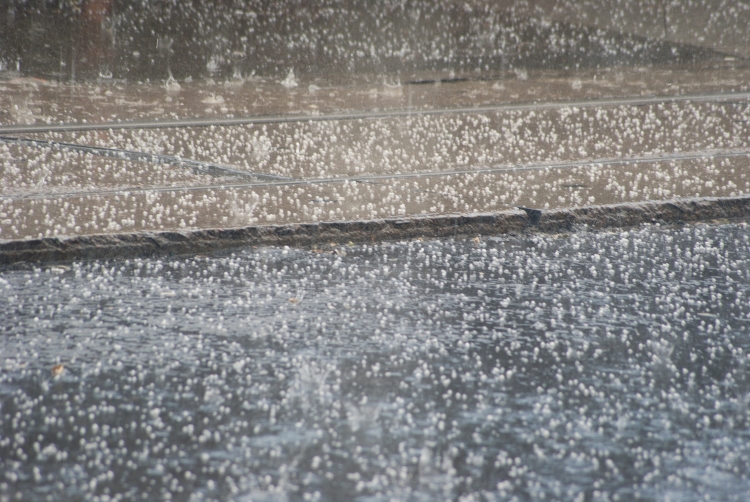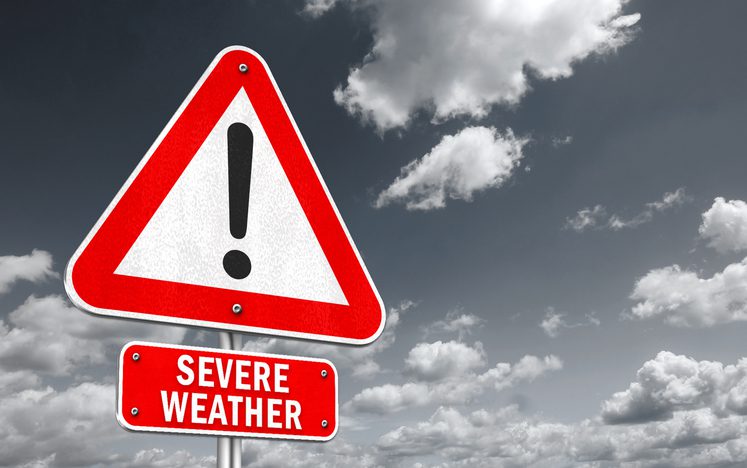Hail—pellets of frozen rain that may fall at speeds of more than 100 miles per hour—can cause more than a billion dollars in damage to property, vegetation and even livestock. In fact, a 2016 hailstorm in San Antonio, Texas resulted in $1.4 billion in damage as baseball-sized hail shattered windshields on cars and punctured roofs on homes.
Hail is often the result of severe thunderstorms: as fast updrafts of air carry raindrops into the cold upper atmosphere, these droplets freeze and fall back to earth as ice. The stronger the updraft, the more the hailstone can continue to grow. For this reason, small, pea-sized hail that causes no damage may hit one area, whereas larger, quarter-sized hail that damages everything in its path could hit another area just blocks away.
“Hail Alley,” where Nebraska, Colorado and Wyoming meet, averages seven to nine hail days a year, according to the National Severe Storms Laboratory. But even if you don’t live in one of these states, that doesn’t mean you’re safe from hail. In fact, the largest hailstone ever collected in the U.S. fell in Vivian, South Dakota. (It was 8 inches in diameter and weighed almost 2 pounds.) Nearly all of the U.S. is at risk, but areas that experience cool temperatures and high winds and that frequently have severe thunderstorms are particularly prone to hail.
Predicting a Storm
Although it can be difficult to predict exactly when and where hail will appear, keeping an eye out for certain signs may help. For example, the sky may turn a greenish tint shortly before it begins to hail. Hail forms in tall cumulonimbus clouds—also known as thunderheads—and you may be able to see a “hail shaft,” a white column of falling hail that descends from the storm cloud towards the ground as it approaches your area.
Keep in mind, however, that you may not notice any particular signs that hail is headed your way. For this reason, it’s very important to follow the weather forecast. Check your local weather often, particularly during the months when hail is common in your area.
Once a severe thunderstorm has been spotted in your area, be on alert for hail. Pay closer attention to the weather reports, as hail warnings may be issued only moments before hail starts to fall. Once a hailstorm is forecast, plan to remain indoors if possible.
Before the Storm
You can minimize the potential damage from a storm by planning ahead. Consider taking these long- and short-term preventative measures to protect your home and car from hail damage:
Have the right kind of roof on your home.
Large hail can cause roof damage, which can lead to water leakage and other problems. Fortunately, there are roofing materials that are built to better withstand damage from hail and other types of impacts. For example, asphalt and tile are ranked based on how well they can withstand hail. If you’re in the market for new roofing material, look for products with a “Class 4″ rating—these have been found to hold up well against hail.
Keep your car in a hail-safe location.
If hail is expected in your area in the near future, consider delaying any automobile trips until after the storm has passed. Move your car to a covered parking spot, such as a garage or a carport. If you don’t have access to one, now is a good time to consider buying an automobile cover specifically designed to withstand hail. Although a cover may not protect your car completely from very large hail, it can help to minimize the damage.
You can find such covers by searching online for “car cover hail protection.” If you do not have enough time to purchase such a cover, consider layering the roof, hood and windshield of your car with blankets, car mats, wood boards or other materials to protect the car from hail damage. Any kind of covering can help to soften the blow.
During the Storm
If a hailstorm hits while you’re driving, carefully pull over to the side of the road as soon as possible. A moving car is more likely to suffer hail damage, as the impact of the hail is compounded by the speed of the car. If possible, try to find a sheltered location to pull into, such as a public parking garage or even under a remote overpass.
To avoid personal injury, remain in the car until the hail ends. Turn away from the windows, and cover your eyes, even if all you have is a piece of clothing. If possible, crouch or lay face-down on the floor of your vehicle. Do not start driving again until the hail has stopped.
If you’re at home when a hailstorm hits, keep away from the windows. If struck by a hailstone, they can shatter and cause injury. Consider moving valuable objects away from the windows as well, just in case hail breaks through.
If you’re outside, move indoors immediately. If you cannot protect your entire body as you move indoors, at least protect your head. Seek shelter under trees only as a last resort, as lose branches may fall or the tree itself may attract lightning.
After the Storm
Once the hailstorm has passed, check for property damage promptly. Survey your home and automobile for any dents, shattered glass or water leakage. If you suspect damage, hire a professional to inspect your property and to document their findings.
If you’re a customer of The Hartford, you can contact us to file a claim anytime. Make sure to work with a reputable contractor or auto-body shop experienced in repairing hail damage. For more information on how The Hartford can help protect your property, review our auto and homeowners coverages.
Hail can cause serious damage to your home, car and other personal property, but following a few basic steps can help reduce the risk of damage dramatically.







Is my vehicle protected from hail damage now?
Hi David – To discuss your specific policy and what it covers in more detail, please give us a call at 800-423-6789. Thanks for reading Extra Mile!
What is the cost of insuring a car against a hail storm.
Hi Ethel – Thanks for reading Extra Mile! To get a quote for car insurance, please give us a call at 888-546-9099.
Do all car insurances cover hail damage or is that a separate policy?
Hi Lourdes – Typically, comprehensive coverage helps cover hail damage. To discuss your policy and what it covers in more detail, please give us a call at 800-423-6789.
Thanks this was helpful
i should be covered –right ??
Thanks for the information.
Hi do I need to add on to my insurance plans for hail protection? Or, does my home owners and car insurance. Automatically have it factored in
Hi Paige – To discuss your policy and what’s covered in more detail, please give us a call at 800-423-6789. You can also find more information on auto and home insurance coverages on our website.
Am I covered on my homeowners and auto for hail damage?
Hi John – To learn more about what’s covered through your policies, please give our customer service representatives a call at 800-423-6789. Our website also has general information on auto and homeowners insurance coverages.
make a dollar store pool noodle car cover
I have auto and Renters insurance with you, but how much would it cost me for Hail storm damage on the car
Hi Gail – For your question, please give our customer service representatives a call at 800-423-6789. Thanks for reading Extra Mile!
I am interested I. Home insurance
Please contact me
Hi Anne – Please call 877-422-2345 and one of our customer service representatives would be happy to provide you with a quote. Thanks for reading Extra Mile!
This article on protecting self and car during a hail storm IS REALLY VALUABLE to me!!! I never knew this stuff. I’ve always just “enjoyed” being in a hail storm. Now I know better! Thanks for the insights.
I had just such a thing happen to me last Wednesday from a Thunderstorm that had hail with it. It came down so hard on the roof of the Apartment building you could hear it. The next morning I seen that my windshield was cracked, but I looked at the other cars mine was the ONLY one that was damaged. This apartment complex has NO SHELTER TO PARK CARS FROM ANY BAD WEATHER ☁️. I got it fixed from Safelite the Tech Alan was Great. I would definitely use them again. Thanks to The Hartford for their referral.
Am I covered for Hail damage??
Hi Steve – For specific questions about your policy and what’s covered, please give us a call at 800-423-6789. You can also visit our main website to learn more about auto and home insurance coverages.
Thank you for sending these great educational tips! Much appreciated.
Am I protected for hail damage?
Hi Ruby – To discuss your policy and coverages in more detail, please give us a call at 800-423-6789. You can also learn more about auto and homeowners insurance coverages on our website.
Hail storms can damage cars and if not handled properly or if not prepared, it can cost a lot of money for fixing it. These tips are really helpful in order to protect someone’s car and home from hail damage.
Very interesting points you have remarked, appreciate it for putting up.
How effective is this hail cover protection for cars?
https://www.hailprotector.com/store/#!/CAR1-HAIL-PROTECTOR-Cover-System-175-in-length-and-below-Any-Size-Hail-FREE-SHIPPING-&-FREE-MOBILE-APP-mobile-app-is-USA-only/p/24093171
I was driving a Chevrolet Uplander van last summer, in the Ottawa Valley, when a very sudden storm blew in. The first thing I saw was what looked like snow blowing across the road, as in a blizzard, with no upper level wind or precipitation, then it suddenly got dark with a strong wind. I was lucky to be going through a small town, so pulled off into a lumberyard as the hail, driven by a strong wind, began. There was no shelter, so I parked with the back of the van turned into the wind, to afford as much protection as possible to the large windshield. Fortunately, the hail only reached the size of a half inch in diameter.